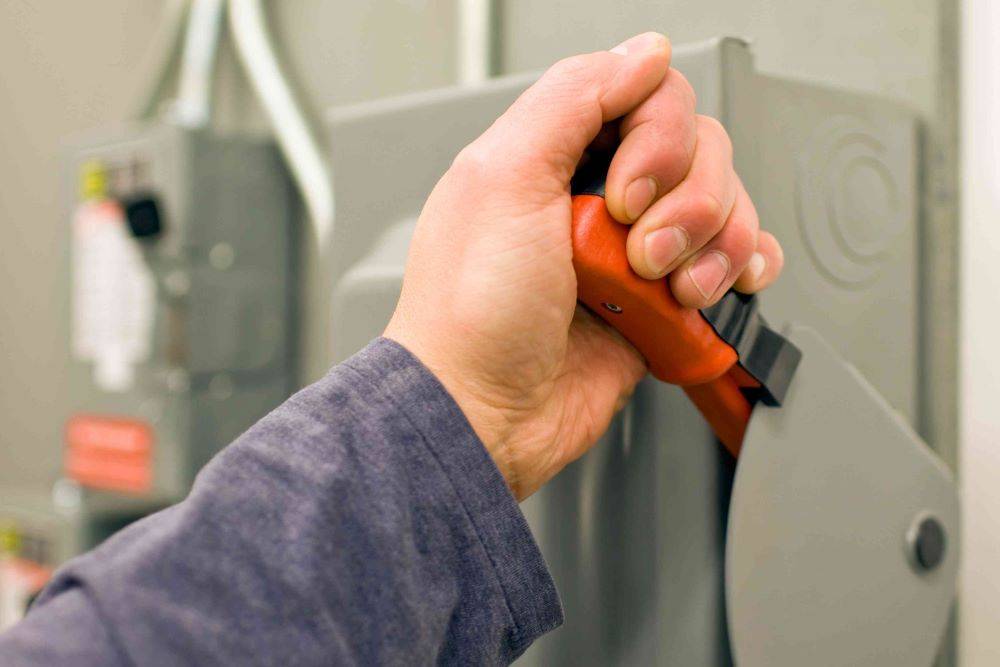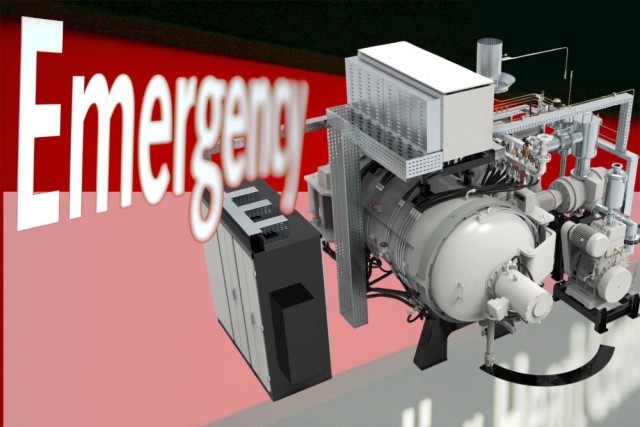Power Outage
Immediate Actions
In the event of a power outage, swift action is imperative to mitigate potential damage to the vacuum sintering furnace. The first step is to address any interruption in the water supply. If water is cut off, activate the backup cooling water system immediately and ensure a continuous water supply is reestablished. This ensures that the furnace remains within safe operating temperatures and prevents overheating.
If the furnace is not currently in a warming, heating, or cooling cycle, it is crucial to restart the equipment as soon as possible. This minimizes downtime and ensures that the furnace can resume its operations without delay. However, if the furnace is actively engaged in a heating or cooling cycle, the restart process must be approached with caution. Restarting the furnace during these cycles should only be done when it is feasible and safe to do so. If the outage is prolonged, allowing the furnace to cool naturally may be the safest option to prevent thermal stress and potential mechanical failure.
To summarize, the immediate actions during a power outage involve:
- Activating the backup cooling water system if the water supply is cut off.
- Restarting the furnace if it is not in a warming, heating, or cooling cycle.
- Exercising caution when restarting the furnace if it is in a heating or cooling cycle, opting for natural cooling in prolonged outages.

Heating Power Supply Loss
Water Pressure Issues
Low water pressure is a critical issue that can significantly impact the operation of a vacuum sintering furnace. Specifically, when the water pressure drops below the threshold of 0.15MPa, an immediate response is required to prevent potential damage to the equipment and ensure the safety of the process.
To address this issue, the furnace is equipped with a pressure gauge that triggers an alarm when the water pressure falls below the specified limit. This alarm serves as a critical early warning system, alerting operators to take immediate action. The primary goal during such an event is to restore the water pressure to an acceptable level as quickly as possible.
In scenarios where the water pressure cannot be immediately restored, operators must consider alternative measures. For instance, if the furnace is currently in a heating or cooling cycle, it may be necessary to allow the process to continue and monitor the situation closely. In extreme cases, where the water pressure remains low for an extended period, operators may need to initiate a controlled shutdown of the furnace to prevent damage.
Additionally, it is essential to investigate the root cause of the low water pressure. Possible reasons could include blockages in the water supply lines, issues with the water pump, or leaks in the water cooling system. Addressing these underlying issues is crucial to prevent future occurrences and ensure the continuous and safe operation of the vacuum sintering furnace.
Grounding Faults and Vacuum Discharge
When dealing with grounding faults and vacuum discharge in a vacuum sintering furnace, it is crucial to ensure that all water-cooled electrode connectors and heaters are securely connected. This step is essential to maintain the integrity of the electrical connections and prevent any potential arcing or short circuits. Additionally, the insulation of reflection screens should be thoroughly checked to ensure they are not compromised, which could lead to energy loss or unsafe operating conditions.
If the furnace pressure falls within the range of 13.3-66.5 Pa, it is advisable to monitor the power closely. At these pressures, there is a higher likelihood of dielectric breakdown, which can result in a sudden drop in power. This phenomenon occurs when the insulating properties of the medium between the electrodes break down, leading to a discharge of energy. To mitigate this risk, operators should be prepared to adjust the power settings or take preventive measures to stabilize the pressure within the furnace.
Below is a summary of key actions to take when addressing grounding faults and vacuum discharge:
| Action | Description |
|---|---|
| Secure Connections | Ensure all water-cooled electrode connectors and heaters are firmly connected. |
| Inspect Insulation | Check the insulation of reflection screens for any damage or wear. |
| Monitor Pressure | Keep a close watch on furnace pressure, especially if it falls between 13.3-66.5 Pa. |
| Adjust Power | Be ready to adjust power settings if dielectric breakdown is suspected. |
By following these steps, operators can effectively manage grounding faults and vacuum discharge, ensuring the safe and efficient operation of the vacuum sintering furnace.
Inflatable Gas Stoppage
Gas Pipeline Checks
Before initiating the vacuuming process, it is crucial to ensure that all gas pipelines are free from any obstructions. This preliminary check is essential to prevent any potential hazards that could arise from blocked or malfunctioning gas lines.
Begin by inspecting the solenoid valves and gas filling valves meticulously. These components play a pivotal role in regulating the flow of gas into the system, and any malfunction could lead to significant operational issues.
For safety, it is imperative to halt the operation of all associated equipment during this inspection phase. This precautionary measure ensures that any issues detected can be addressed without the risk of additional complications arising from concurrent equipment operation.
In summary, a thorough inspection of the gas pipelines and associated valves is not just a routine check but a critical safety measure that must be prioritized before proceeding with the vacuuming process.

Pressure Relief Operations
In scenarios where the vacuum chamber continues to fill uncontrollably, it is imperative to engage the pressure relief valve immediately. This action serves as a critical safety measure to prevent overpressure within the chamber, thereby averting potential hazards.
To ensure comprehensive safety, it is essential to shut down all gas systems involved. This includes closing supply valves and isolating the piping network. By doing so, you not only halt the inflow of gas but also prevent any residual gas from further compromising the system's integrity.
| Step | Action | Purpose |
|---|---|---|
| 1 | Operate the pressure relief valve | Prevent overpressure |
| 2 | Shut off all gas systems | Halt gas inflow and isolate system |
These steps are crucial for maintaining the safety and integrity of the vacuum sintering furnace, ensuring that no further complications arise from uncontrolled gas flow.
Leak Detection
Ensuring the integrity of gas filling piping is crucial for maintaining product quality in vacuum sintering furnaces. Regular leak detection should be a standard practice to prevent potential issues that could compromise the sintering process. Gas leaks can lead to inconsistent atmospheres within the furnace, affecting the uniformity and properties of the sintered materials.
To effectively detect leaks, several methods can be employed:
- Bubble Test: This simple yet effective method involves submerging suspect piping sections in a water bath. Any gas leaks will produce bubbles, indicating the location of the leak.
- Pressure Testing: By pressurizing the gas lines and using a pressure gauge, you can monitor for any drops in pressure over time, which would signify a leak.
- Ultrasonic Leak Detectors: These devices use sound waves to detect the high-frequency hissing sounds produced by escaping gas, pinpointing the exact location of the leak.
| Detection Method | Advantages | Disadvantages |
|---|---|---|
| Bubble Test | Simple, Inexpensive | Limited to visible leaks, may require disassembly |
| Pressure Testing | Accurate, Non-destructive | Requires specialized equipment, time-consuming |
| Ultrasonic Detectors | Highly accurate, Quick detection | Expensive, requires training to use effectively |
Regular leak detection not only safeguards product quality but also ensures the safety of the operating environment by preventing potential gas hazards.
Related Products
- Vacuum Heat Treat and Pressure Sintering Furnace for High Temperature Applications
- Small Vacuum Heat Treat and Tungsten Wire Sintering Furnace
- Vacuum Hot Press Furnace Machine Heated Vacuum Press
- Vacuum Dental Porcelain Sintering Furnace
- 2200 ℃ Graphite Vacuum Heat Treat Furnace
Related Articles
- Vacuum Hot Press Furnace: A Comprehensive Guide
- Mastering Vacuum Furnace Brazing: Techniques, Applications, and Advantages
- Exploring the Advanced Capabilities of Spark Plasma Sintering (SPS) Furnaces
- Comprehensive Guide to Vacuum Hot Press Furnace Application
- How Vacuum Induction Melting Ensures Unmatched Reliability in Critical Industries















